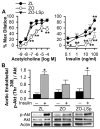Mineralocorticoid receptor antagonism treats obesity-associated cardiac diastolic dysfunction
- PMID: 25712719
- PMCID: PMC4393340
- DOI: 10.1161/HYPERTENSIONAHA.114.04912
Mineralocorticoid receptor antagonism treats obesity-associated cardiac diastolic dysfunction
Abstract
Patients with obesity and diabetes mellitus exhibit a high prevalence of cardiac diastolic dysfunction (DD), an independent predictor of cardiovascular events for which no evidence-based treatment exists. In light of renin-angiotensin-aldosterone system activation in obesity and the cardioprotective action of mineralocorticoid receptor (MR) antagonists in systolic heart failure, we examined the hypothesis that MR blockade with a blood pressure-independent low-dose spironolactone (LSp) would treat obesity-associated DD in the Zucker obese (ZO) rat. Treatment of ZO rats exhibiting established DD with LSp normalized cardiac diastolic function, assessed by echocardiography. This was associated with reduced cardiac fibrosis, but not reduced hypertrophy, and restoration of endothelium-dependent vasodilation of isolated coronary arterioles via a nitric oxide-independent mechanism. Further mechanistic studies revealed that LSp reduced cardiac oxidative stress and improved endothelial insulin signaling, with no change in arteriolar stiffness. Infusion of Sprague-Dawley rats with the MR agonist aldosterone reproduced the DD noted in ZO rats. In addition, improved cardiac function in ZO-LSp rats was associated with attenuated systemic and adipose inflammation and an anti-inflammatory shift in cardiac immune cell mRNAs. Specifically, LSp increased cardiac markers of alternatively activated macrophages and regulatory T cells. ZO-LSp rats had unchanged blood pressure, serum potassium, systemic insulin sensitivity, or obesity-associated kidney injury, assessed by proteinuria. Taken together, these data demonstrate that MR antagonism effectively treats established obesity-related DD via blood pressure-independent mechanisms. These findings help identify a particular population with DD that might benefit from MR antagonist therapy, specifically patients with obesity and insulin resistance.
Keywords: aldosterone; echocardiography; immune marker; metabolic syndrome X.
© 2015 American Heart Association, Inc.
Figures






References
-
- Pitt B, Pfeffer MA, Assmann SF, Boineau R, Anand IS, Claggett B, Clausell N, Desai AS, Diaz R, Fleg JL, Gordeev I, Harty B, Heitner JF, Kenwood CT, Lewis EF, O’Meara E, Probstfield JL, Shaburishvili T, Shah SJ, Solomon SD, Sweitzer NK, Yang S, McKinlay SM. Spironolactone for heart failure with preserved ejection fraction. N Engl J Med. 2014;370:1383–1392. - PubMed
-
- Shah AM, Shah SJ, Anand IS, Sweitzer NK, O’Meara E, Heitner JF, Sopko G, Li G, Assmann SF, McKinlay SM, Pitt B, Pfeffer MA, Solomon SD. Cardiac structure and function in heart failure with preserved ejection fraction: Baseline findings from the echocardiographic study of the treatment of preserved cardiac function heart failure with an aldosterone antagonist trial. Circ: Heart Fail. 2014;7:104–115. - PMC - PubMed
-
- Boudina S, Abel ED. Diabetic cardiomyopathy revisited. Circulation. 2007;115:3213–3223. - PubMed
-
- Kosmala W, Przewlocka-Kosmala M, Szczepanik-Osadnik H, Mysiak A, Marwick TH. Fibrosis and cardiac function in obesity: A randomised controlled trial of aldosterone blockade. Heart. 2013;99:320–326. - PubMed
-
- Kosmala W, Przewlocka-Kosmala M, Szczepanik-Osadnik H, Mysiak A, O’Moore-Sullivan T, Marwick TH. A randomized study of the beneficial effects of aldosterone antagonism on lv function, structure, and fibrosis markers in metabolic syndrome. JACC Cardiovasc Imaging. 2011;4:1239–1249. - PubMed
Publication types
MeSH terms
Substances
Grants and funding
LinkOut - more resources
Full Text Sources
Medical

